What Is A Good Size Cam To Put In 4.3 V6
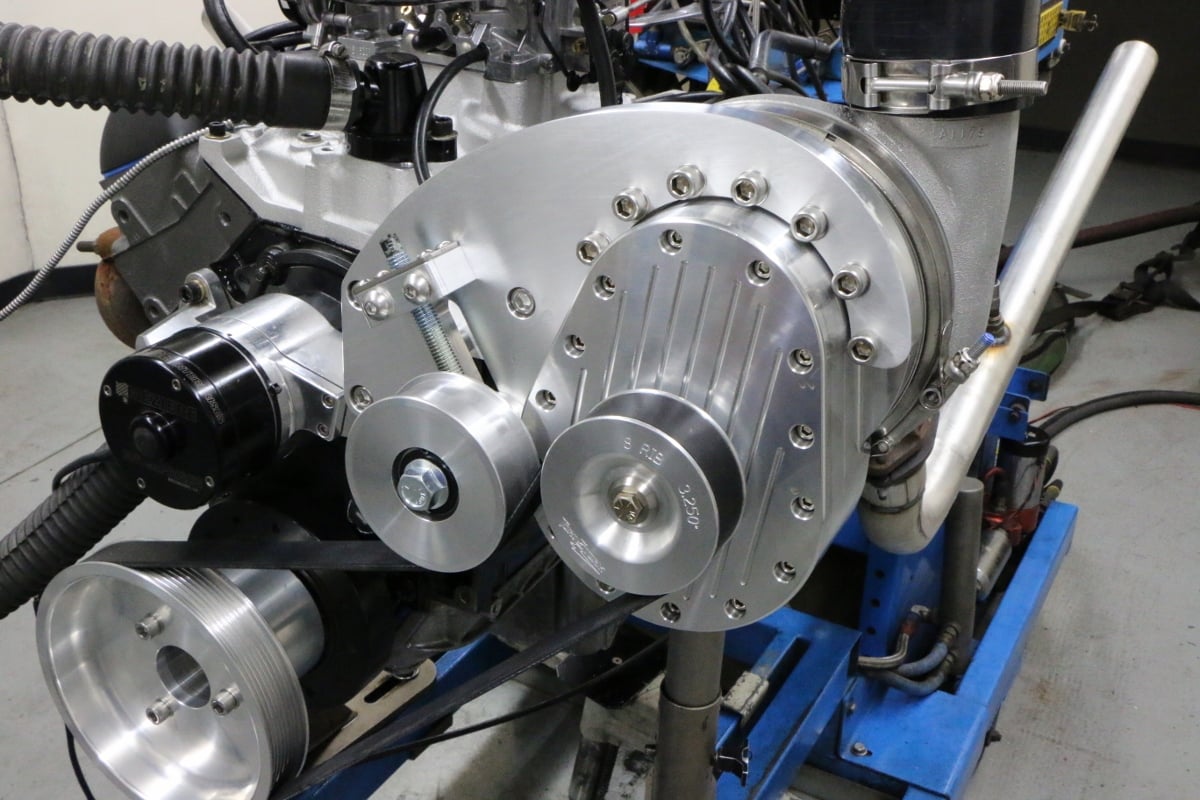
Did nosotros just add a supercharger to a pocket-sized-cake V-eight? Look once again, that examination motor was shy a couple of cylinders!
Words by Richard Holdener
Making ability with a big motor is easy; all you have to do is feed the displacement with head flow, cam timing, and a good induction system, and yous are ready. Making power with less displacement becomes more than difficult, but, as this exam clearly proves, not impossible.
The key to ability extraction for the displacement challenge is obviously boost. There is no better equalizer for cubic inches than a petty positive pressure. While adding boost to a stock motor will yield substantial benefits, adding ability to a modified one is even ameliorate. The actress power offered past the heads, cam, or intake upgrade is really multiplied past the available boost pressure. To illustrate the torque benefits of boost on a smaller motor, we decided to storm a Chevy 4.3L V-6.
The iv.3L Five-vi was Chevrolet'due south most successful Five-6 platform, and for good reason. Though offering only half dozen cylinders, the 4.3L shared considerable hardware with the small-block V-8. In essence, the four.3L was a 5-8 minus a pair of cylinders (three and half-dozen). Like the 350 Chevy, the four.3L combined a 4.0-inch bore with a 3.48-inch stroke. The shared displacement facilitated parts interchange between the 5-eight and V-6, including pistons.
Though the V6 utilized the same v.vii-inch rod length, the Five-eight and 5-6 rods differed in rod journal diameter (due to the thirty-caste commencement rod journals), and therefore did not interchange. Still, the V-half dozen did share the bore spacing, deck meridian, and many valve train components with the V-eight.
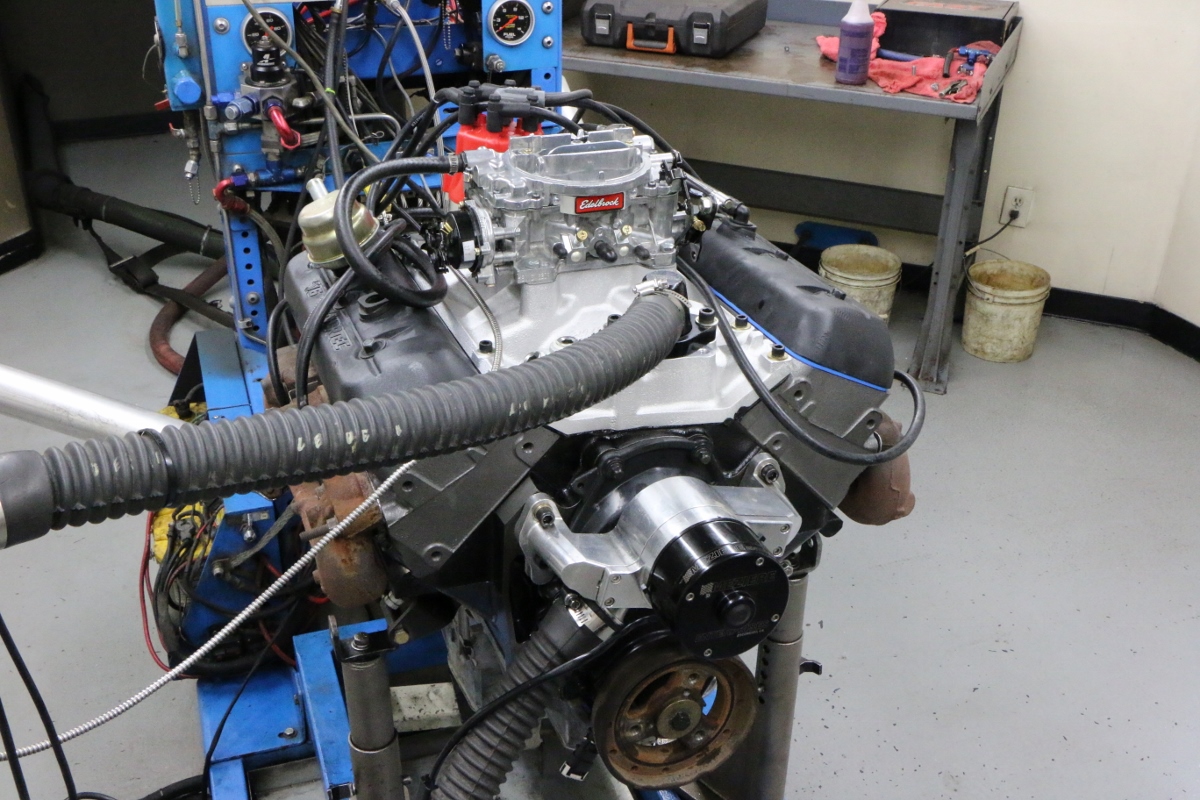
Run in normally aspirated trim, the cammed and carbed V-6 produced 251 hp and 298 lb-ft of torque.
What this meant is that those shared components for the Five-6 were readily available at affordable prices. It also meant that the V-6 received many of the upgrades practical to the Five-viii over the years, including hydraulic roller cams, one-piece rear chief seals, and fifty-fifty the much-praised Vortec cylinder heads.
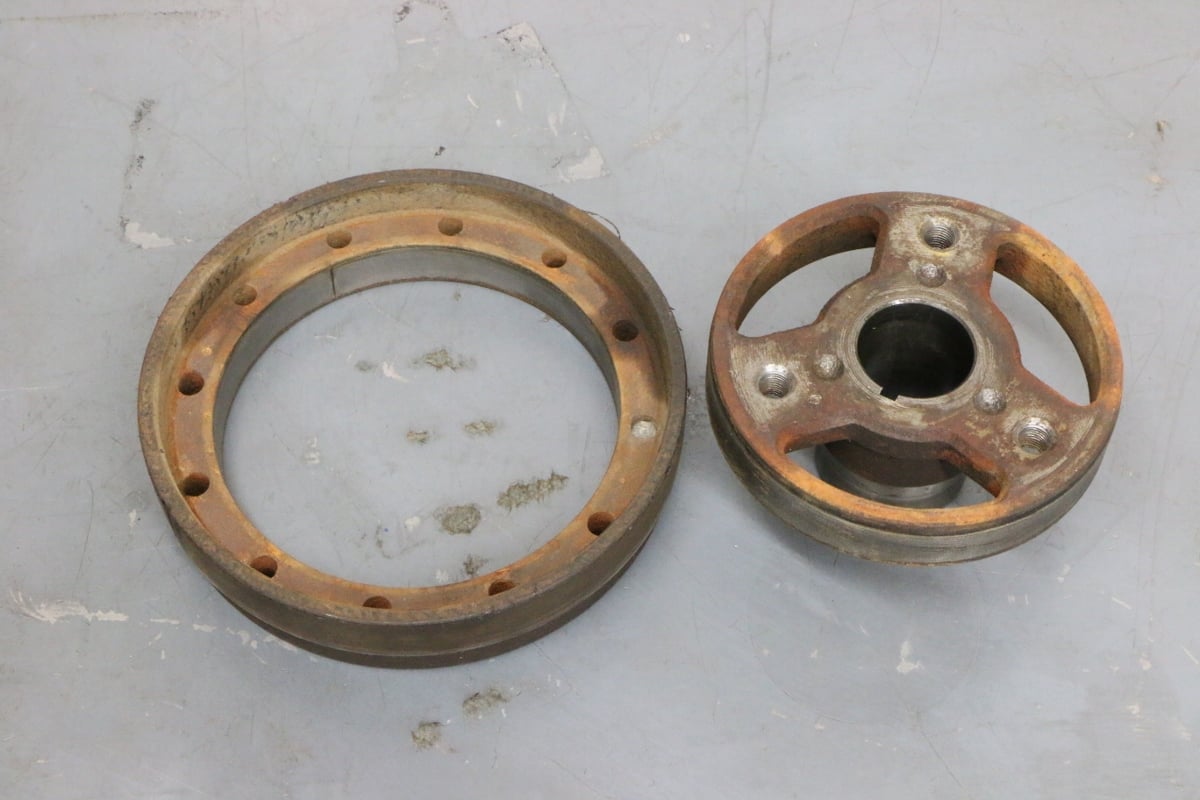
While running the motor in normally aspirated trim, the mill damper permit get in spectacular mode. To continue testing, we installed a neutral-balance, small-block V-8 damper from Speedmaster.
Knowing the 5-6 received the many upgrades, nosotros chose accordingly for our build up. The examination motor started out life as a 2002 iv.3L from an Astro Van. The 2002 model featured non only the i-piece rear seal, hydraulic-roller valve train, and the loftier-menstruum Vortec heads, but too a dedicated balance shaft. Unlike V-8s, the V-6 blueprint was inherently prone to vibration. Use of a balance shaft helped counter some of the unwanted vibration, making these later 4.3Ls much smoother in operation, specially if you plan elevated rpm in a performance application.
Though our Five-half dozen was essentially a rebuild of the long-cake components (with .030-over pistons), we did replace some of the factory components earlier adding boost. Naturally, we ditched the problematic fuel injection for simple and effective carburetion. The EFI intake was replaced past an Edelbrock Performer intake and matching 500 cfm Thunder-Series carburetor. The carbureted induction system required replacement of the computer-controlled distributor with a conventional unit from MSD.
Once the 5-half dozen was topped with carburetion, we took a look inside the motor, more than specifically to the cam timing. Naturally, the factory cam timing was purposely mild, and ill-suited to our needs. If you want to find out but how much power our cam was worth, check out the story "The Missing Link" in Power & Functioning News. The stock cam was replaced with a COMP 280HR grind that offered .525 elevator, 224-degrees of duration (at .050), and a 110-degree lsa. The 280 cam was a solid step up the functioning ladder, but could hardly be considered a total (or even iii/4) race grind.
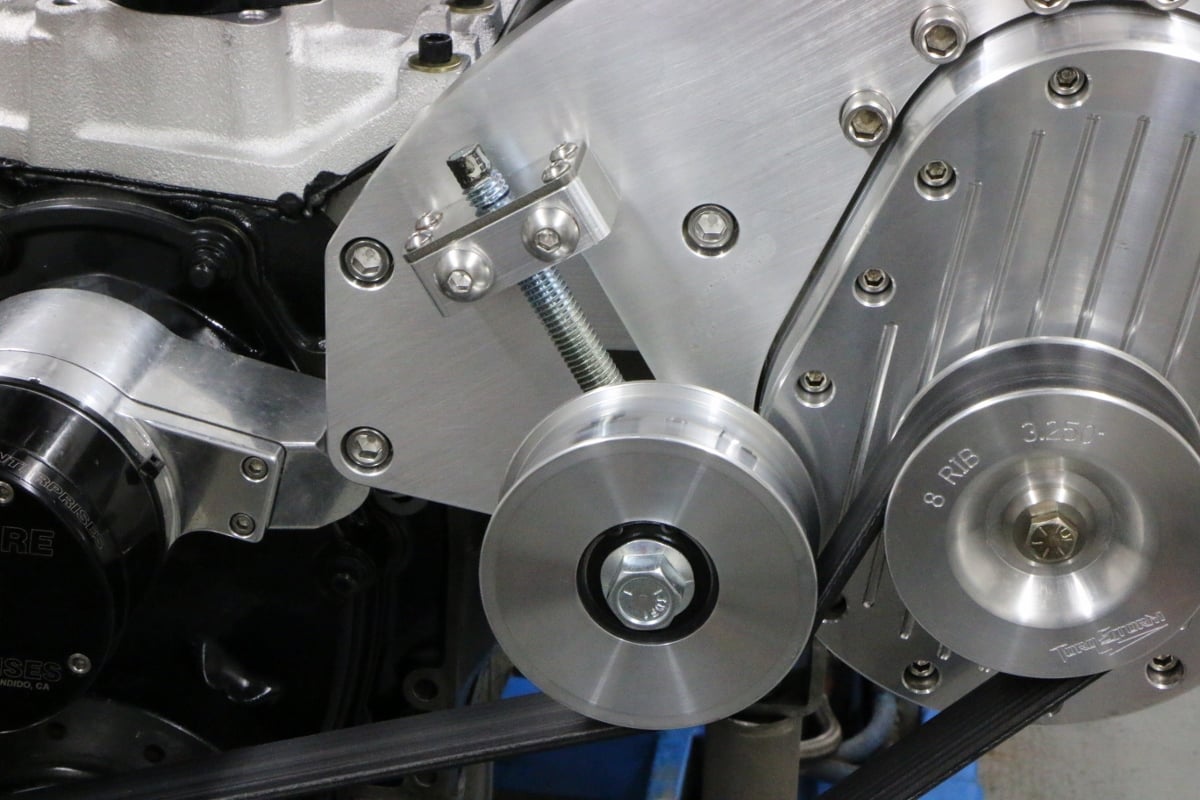
The blower mount featured a dedicated tensioner caster to tighten the blower chugalug. Once tightened, we locked information technology in place using the pulley bolt.
The cam was teamed with a new set of hydraulic roller lifters from COMP Cams. The hydraulic roller valvetrain was one of the many benefits of using this later iv.3L configuration, every bit it immune for more aggressive cam profiles (only possible with a roller follower). The 2002 V6 besides featured roller-fulcrum rockers (not unlike an LS V-viii), only we did upgrade the stock valve springs on the Vortech heads with a gear up of 26915 beehives, also from COMP Cams.
A ready of long-tube headers was the but missing performance ingredient, but run in anger with the stock exhaust manifolds, the carbureted and cammed iv.3L produced 251 hp and 298 lb-ft of torque. Now it was time for boost!
Boost for our V-6 was supplied by a TorqStorm centrifugal supercharger originally designed for a small-block 5-8. The 4.3L shared many of the accessories and water pump mounts with the Five-viii, so the TorqStorm kit bolted right in identify. Since the kit's designed to blow through a carburetor using the supplied carb bonnet, we opted to supercede the Edelbrock carb for a Carb Solutions Unlimited unit designed for heave.
The combination of metering block modifications, bachelor jetting and adjustable (boost-referenced) power valves allowed united states of america to punch in the air/fuel mixture nether the rising boost curve supplied by the TorqStorm supercharger. The supercharger kit was supplied with an viii-inch crank caster and 3.25-inch blower pulley.
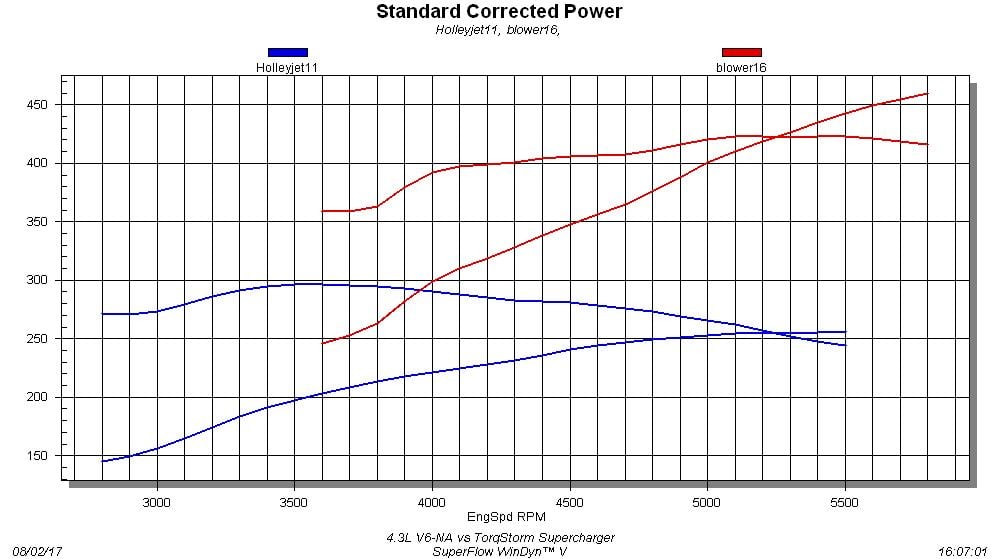
4.3L V6-Na vs TorqStorm (13.iii psi)
Like every other motor in existence, the 4.3L V-half dozen responded well to boost. Just enquire a Typhoon or Syclone owner. Running an Edelbrock intake, Thunder Series carb, and COMP cam, the 4.3L produced 251 hp and 298 lb-ft of torque. After installation of the TorqStorm supercharger and CSU blow-through carburetor, the power output jumped to 460 hp and 423 lb-ft of torque. The peak boost pressure registered during the run was xiii.three psi, which occurred at v,800 rpm. Both the heave and power curves were still rise at our self-imposed shut off betoken.
This produced a peak heave reading on our V-6 of thirteen.3 psi at 5,800 rpm, though in that location was enough more boost and ability left on the table. Nosotros comfortably exceeded 620 hp on a 5.0L V-8 application using this exact blower and pulley configuration, so the sky is the limit if you built a serious V-6 to handle the actress boost. All dialed in, the TorqStorm supercharged 5-six produced 460 hp (459.viii to exist verbal) at five,800 rpm and 423 lb-ft of torque.
Sources: COMP Cams, compcams.com; CSU, csucarbs.com; Edelbrock, edelbrock.com; Holley, holley.com; Lucas Oil, lucasoil.com; MSD, msdignition.com; Speedmaster, speedmaster79.com; TorqStorm, torqstorm.com
What Is A Good Size Cam To Put In 4.3 V6,
Source: https://www.streetmusclemag.com/tech-stories/4-3l-storm-warning-v8-power-from-your-v6/
Posted by: yoderhadegre.blogspot.com


0 Response to "What Is A Good Size Cam To Put In 4.3 V6"
Post a Comment